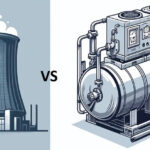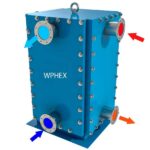Introduction
Superheating in heat exchangers is a crucial process that involves raising the temperature of a vapor or gas above its saturation point. It plays a significant role in various industrial applications, offering enhanced heat transfer efficiency and precise temperature control. In this article, we will explore the concept of superheating in heat exchangers, its importance, and how it impacts heat transfer and overall system performance. By optimizing the use of superheating, industries can achieve improved energy utilization, better heat exchange rates, and increased operational efficiency.
Section 1: Understanding Superheating in Heat Exchangers
Superheating in heat exchangers refers to the process of elevating the temperature of a vapor or gas beyond its saturation temperature while maintaining a constant pressure. Saturation temperature is the point at which a substance changes phase from a liquid to a vapor or gas at a specific pressure. By superheating the steam or gas, we increase its thermal energy content, leading to several benefits in heat exchanger systems.
Section 2: Importance and Advantages of Superheating
Superheating offers several advantages in heat exchanger applications. Firstly, it enables precise temperature control, which is critical in industries where maintaining specific temperature ranges is essential for optimal operations. Additionally, superheated steam or gas provides higher energy content, resulting in improved heat transfer rates and enhanced overall system performance. These advantages make superheating a valuable tool for industries seeking efficient heat exchange processes.
To summarize below:
Generally, superheating affects the heat duty in the following ways:
- Increased heat duty: Superheating the steam or gas increases its temperature above the saturation point. This elevated temperature requires additional heat input to achieve and maintain the superheated state. Therefore, the heat duty of the heat exchanger will be higher compared to a system without superheating.
- Enhanced heat transfer: Superheated steam or gas has higher thermal energy content compared to saturated steam or gas at the same pressure. This increased energy content can result in improved heat transfer rates in the heat exchanger. Consequently, the heat duty of the heat exchanger may be more efficiently achieved due to the higher temperature differential between the superheated fluid and the fluid being heated or cooled.
- Temperature control: Superheating allows for better temperature control in heat exchanger applications. By superheating the steam or gas, it is possible to achieve precise and consistent temperatures, which is crucial in various industrial processes. This improved temperature control helps optimize the heat duty and ensures accurate heat transfer in the heat exchanger.
Section 3: Impact on Heat Duty and Energy Efficiency
Superheating directly affects the heat duty in a heat exchanger. By increasing the temperature of the steam or gas above its saturation point, additional heat energy is required to achieve and maintain the superheated state. Consequently, the heat duty of the heat exchanger increases compared to systems without superheating. However, the enhanced heat transfer characteristics of superheated fluids can compensate for the higher heat duty, resulting in improved energy utilization and overall efficiency.
Section 4: Calculating Heat Duty with Superheating
Calculating the heat duty in a heat exchanger involving superheating requires considering the specific conditions and properties of the working fluid. By determining the enthalpy (heat content) of the incoming saturated steam and the desired superheated steam, the heat duty can be calculated using the mass flow rate of the fluid. The heat duty represents the amount of heat energy required to achieve the desired superheating. Accurate calculations help in system design, equipment selection, and optimization of energy consumption.
Example of calculating the heat duty in a heat exchanger involving superheating
Suppose you have a heat exchanger that is used to superheat steam. The incoming saturated steam enters the heat exchanger at a pressure of 10 bar and a temperature of 180°C. The desired superheated steam temperature at the outlet is 300°C. The mass flow rate of the steam is 5,000 kg/h. You need to determine the heat duty required to achieve this superheating.
To calculate the heat duty, you can use the following steps:
+ Determine the enthalpy of the incoming saturated steam:
Use steam tables or software to find the specific enthalpy (heat content) of saturated steam at the given conditions of 10 bar and 180°C. Let’s assume the enthalpy is h1 = 2,500 kJ/kg.
+ Determine the enthalpy of the desired superheated steam:
Again, refer to steam tables or software to find the specific enthalpy of superheated steam at the outlet temperature of 300°C and the same pressure of 10 bar. Let’s assume the enthalpy is h2 = 3,500 kJ/kg.
+ Calculate the heat duty:
The heat duty (Q) is given by the equation:
Q = m * (h2 – h1)
where m is the mass flow rate of the steam.
Plugging in the values, we have:
Q = 5,000 kg/h * (3,500 kJ/kg – 2,500 kJ/kg)
= 5,000 kg/h * 1,000 kJ/kg
= 5,000,000 kJ/h
Therefore, the heat duty required to superheat the steam is 5,000,000 kJ/h or 5,000 MJ/h.
Section 5: Applications and Industrial Implementations
There are applications in various industries. Power generation facilities utilize superheated steam in turbines to generate electricity efficiently. Industries involved in heating processes, drying applications, and specific chemical processes benefit from the precise temperature control and enhanced heat transfer provided by superheated steam or gas. By understanding the its potential in different contexts, industries can optimize their operations and achieve better overall performance.
This calculation provides an estimate of the heat duty required to achieve the desired superheating in the heat exchanger. However, it’s important to consider factors such as heat losses, inefficiencies, and any other specific conditions or constraints of the heat exchanger system for a more accurate analysis.
Conclusion
Superheating plays a vital role in heat exchangers, offering improved heat transfer efficiency, precise temperature control, and enhanced system performance. By raising the temperature of the working fluid beyond its saturation point, industries can achieve better energy utilization and optimize heat exchange rates. The calculation of heat duty in superheating applications helps in the design and operation of heat exchanger systems. With the continued focus on energy efficiency and sustainability, harnessing the benefits of superheating in heat exchangers becomes increasingly important for industries across various sectors.
External tools
Heat duty calculator – Software – Android application











